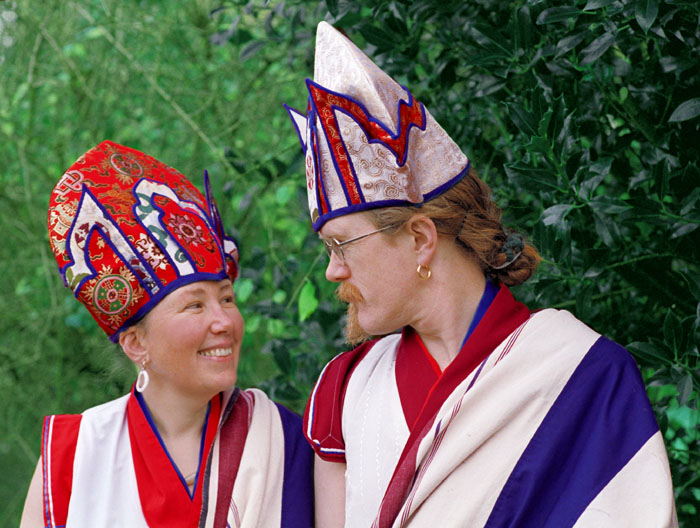
Ngala Nor’dzin & Ngala ’ö-Dzin
– a teaching couple of the Aro Tradition
Ngala Nor’dzin and Ngala ’ö-Dzin are pictured in the formal robes and symbolic ornaments of teaching Lamas within the Aro gTér Lineage. They demonstrate through their daily lives their devotion to their Lamas, Ngak’chang Rinpoche and Khandro Déchen, and the Nyingma gTérma Lineage of Khyungchen Aro Lingma.
Teaching couples, like Ngala Nor’dzin and Ngala ’ö-Dzin, offer practitioners a wonderful opportunity to grasp and experience the realised meanings of teachings. According to Sutrayana a teacher of the same gender is preferred. According to Tantrayana however (in relation to the gö kar chang lo) two Lamas are preferred: a teaching Lama of the inverse gender and a rôle model Lama of the same gender. In terms of Dzogchen, the gender of the teacher is irrelevant. A teaching couple therefore covers all these permutations and the teachings of all the yanas become accessible to the practitioner.
Ngala Nor’dzin and Ngala ’ö-Dzin also demonstrate through their relationship, both with each other and with their children, and also with the world at large, the value of relationship as a fundamental teaching of Vajrayana. They facilitate their students’ capacity to understand relationship as an expression of nondual wisdom and active compassion.
In the Khandro Pawo Nyi-da Mélong Gyüd (mKha’ ’gro dPa bo nyi zLa me long rGyud), wisdom is understood as the outer quality of women – with active compassion as their inner secret quality. Conversely active compassion is seen as the outer aspect of men – with wisdom being their inner secret quality. Through loving, committed relationship, a couple can realise the authentic nature of their inner occluded qualities. They achieve this through appreciation of outer qualities of their partner, which serve as a reflection of their own inner qualities. This dance of reflection and appreciation provides endless opportunities for realisation.
Through their lives, their relationship, and their work as Lamas – Ngala Nor’dzin and Ngala ’ö-Dzin inspire the practice of their apprentices and all those who meet them in the context of Vajrayana.
